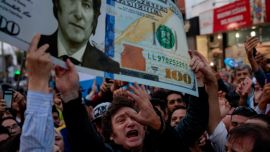Javier Milei’s push to dollarise the Argentine economy is in many ways a long shot. For starters, the political outsider still has to clinch victory in October’s presidential election. Once in office, he’d then have to overcome a slew of obstacles to scrap the peso as the country’s legal tender.
But the truth is many Argentines aren’t waiting around to see how it plays out. They’re dollarising the economy on their own — one transaction and one contract at a time.
In industries such as technology and finance, skilled workers are demanding salaries be paid in dollars. Companies, including MercadoLibre, Argentina’s largest tech company, increasingly are acquiescing. Most landlords in Buenos Aires now only accept payments in dollars. Ditto for Airbnb rentals. And the list goes on and on: musical instruments, divorce lawyers, imported leather — you want it, you cough up the greenbacks.
The use of the dollar, while hardly new here, is exploding across the country today as inflation soars above 100 percent and destroys the value of the pesos people lug around in their wallets and stick into their checking accounts. It’s a classic breakdown of a fiat currency, just like the one witnessed in hyperinflation-ravaged Venezuela a decade earlier: Confidence and trust in the currency collapse to the point where people don’t want to use it for even the most basic of transactions, and so it gradually vanishes from the economy.
“When there’s no demand for a product,” Milei said in an interview last week, “its value is zero.”
The peso’s value isn’t quite zero yet but it is in free-fall. In the government-controlled market, one peso fetches less than a third of a US penny. In the black market, it’s worth even less: one-tenth of a penny. It has sunk 23 percent in the past month alone, the biggest decline among all currencies tracked by Bloomberg, and 91 percent over the past five years. This has deepened an inflation surge that’s been fuelled in large part by the Central Bank’s willingness to print money to finance the government’s budget deficits.
Salaries in dollars
In Argentina’s burgeoning tech industry, an estimated 200,000 people work off the books for companies abroad to get paid in dollars or euros and dodge income taxes, according to Argencon, a trade group that counts MercadoLibre among its members. A report by the group found that the turnover rate for workers in peso-paying jobs has surpassed 30 percent at several tech firms over the past year.
To stem the attrition, MercadoLibre, with over 10,000 employees in Argentina, is one of many companies that at least pay part of salaries in dollars and the other part in pesos. Consulting giant Accenture, software company Globant SA and fintech firm Uala have all begun implementing similar pay structures, too, according to corporate filings, employees and local media reports.
“This benefit is given to employees who are in high demand with local companies as well as with organisations that don’t operate in Argentina but hire top talent by offering salaries in foreign bank accounts,” Uala said in response to questions. The fintech offers between 10 to 40 percent of salaries in dollars depending on the position, and performance bonuses are in greenbacks too, it said.
MercadoLibre and Accenture didn’t reply to a request for comment. Globant declined to comment — earlier this month, the company’s CEO said in an interview that the nation’s economic troubles were contributing to a brain drain.
For those business owners left behind, like Adrian Turjanski, the speed at which this new trend is picking up is alarming. The director of DNA-testing company Bitgenia, Turjanski says he simply isn’t in a position to offer pay cheques in dollars. To try to retain staff, he’s increased skills training for junior employees. But he’s quickly detected a problem with this plan: Once the workers have strengthened their resumes, they often leave for jobs that pay in dollars.
“We’re doing big companies a favour,” Turjanski said, “and that’s lethal.”
Greenback obsession
Argentines’ obsession with the dollar began decades ago, the result of a never-ending series of crises, devaluations and inflation spirals. Once, in the 1990s, the government even tried a scheme similar to dollarisation in which it pegged one dollar to one peso until the system collapsed in 2001.
Argentines have long kept money in savings accounts in greenbacks, and the country routinely ranks among the biggest importers of dollar bills. Big-ticket purchases like homes and used cars are almost entirely done in US currency, too.
But what’s changing now is the amount of transactions and industries that are flipping from pesos to dollars.
In Buenos Aires, for instance, more than 60 percent of rental apartment listings are now priced in dollars, according to ZonaProp, a real-estate website. Two years ago, that number was 20 percent. And the other day, the staff at Roux, a bistro in the city’s upscale Recoleta neighbourhood serving raw oysters, caviar and Argentine beef, changed some of the menu prices into dollars, something rarely, if ever, seen before.
While increasingly common to now get paid in dollars — at least among those in wealthier circles — Argentines are still nervous talking openly about it for fear of retribution from tax authorities. None interviewed by Bloomberg News would speak on the record for this story.
Except, of course, Milei and his advisers. They can’t stop talking about it.
“Argentina is already dollarised — de facto dollarised,” Emilio Ocampo, an economist working with Milei, told Bloomberg in a June interview. It’s the way that people have come to protect themselves from the “tax” of inflation, he said. If Milei’s dollarisation plan becomes codified into law, it will be because the country “basically has no other option.”
related news
by Azul Cibils Blaquier & Patrick Gillespie, Bloomberg






















Comments